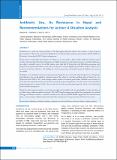Please use this identifier to cite or link to this item:
https://hdl.handle.net/20.500.14356/1745| Title: | Antibiotic Use, Its Resistance in Nepal and Recommendations for Action: A Situation Analysis |
| Authors: | Basnyat, B Pokharel, P Dixit, S Giri, S |
| Citation: | BasnyatB., PokharelP., DixitS., & GiriS. (2015). Antibiotic Use, Its Resistance in Nepal and Recommendations for Action: A Situation Analysis. Journal of Nepal Health Research Council. https://doi.org/10.33314/jnhrc.v0i0.632 |
| Issue Date: | 2015 |
| Publisher: | Nepal Health Research Council |
| Article Type: | Review Article |
| Keywords: | Antibiotics Antibiotic resistance Antibiotic use Bacterial disease Infectious disease Nepal Resistance |
| Series/Report no.: | May-Aug, 2015;632 |
| Abstract: | Abstract Antibiotics are crucial, life-saving medicines in the fight against infectious disease, but resistance to these drugs is growing all over. This article presents key findings from a detailed situation analysis produced by the Global Antibiotic Resistance Partnership (GARP)-Nepal working group. In the absence of nationally-representative surveillance, it is not possible to fully describe antibiotic resistance in the country, but many important bacterial pathogens are highly resistant to most first-line and some second-line antibiotics, according to available reports. In credible studies, more than half of Escherichia coli, Klebsiella pneumoniae and Streptococcus pneumoniae isolates tested, and over 30 percent of some Shigella spp. and Vibrio cholerae isolates were resistant to first-line antibiotics. The findings for Neisseria gonorrheae and hospital-acquired Staphylococcus aureus are similar. Antibiotic use in animal food is poorly documented in Nepal, but it is commonly acknowledged to be widespread, contributing to the overall antibiotic resistance burden. The volume of veterinary antibiotic sales in Nepal rose over 50 percent from 2008 to 2012, most through retailers without veterinarian prescription. Antibiotics are necessary to treat infections in animals, but they are also used extensively for preventing disease, a use that can be restricted without jeopardizing animal or human health. They may also be used for promoting animal growth, which can be eliminated with no health consequences. Nepal has made important advances in reducing mortality and morbidity and increasing health coverage, but has not yet taken steps to address antibiotic resistance. The GARP-Nepal working group outlines the components of a national strategy on antibiotic resistance, consistent with the recent call by the World Health Organization for national action plans, to be developed collaboratively with stakeholders and partners from government and all relevant sectors. Keywords: Antibiotics; antibiotic resistance; antibiotic use; bacterial disease; infectious disease; Nepal; resistance. |
| Description: | Review Article |
| URI: | http://103.69.126.140:8080/handle/20.500.14356/1745 |
| ISSN: | Print ISSN: 1727-5482; Online ISSN: 1999-6217 |
| Appears in Collections: | Vol. 13 No. 2 Issue 30 May - August 2015 |
Files in This Item:
| File | Description | Size | Format | |
|---|---|---|---|---|
| 632-Article Text-1168-1-10-20151231.pdf | Fulltext Downlaod | 295.44 kB | Adobe PDF |  View/Open |
Items in DSpace are protected by copyright, with all rights reserved, unless otherwise indicated.
